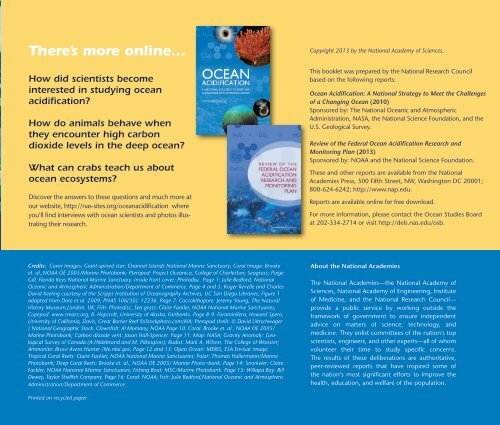OCEAN ACIDIFICATION Starting with the Science
SUMMARY DOCUMENT-Ocean Studies Board The National Academies—the National Academy of Sciences
SUMMARY DOCUMENT-Ocean Studies Board The National Academies—the National Academy of
Sciences
Create successful ePaper yourself
Turn your PDF publications into a flip-book with our unique Google optimized e-Paper software.
There’s more online…<br />
How did scientists become<br />
interested in studying ocean<br />
acidification?<br />
How do animals behave when<br />
<strong>the</strong>y encounter high carbon<br />
dioxide levels in <strong>the</strong> deep ocean?<br />
What can crabs teach us about<br />
ocean ecosystems?<br />
Discover <strong>the</strong> answers to <strong>the</strong>se questions and much more at<br />
our website, http://nas-sites.org/oceanacidification where<br />
you’ll find interviews <strong>with</strong> ocean scientists and photos illustrating<br />
<strong>the</strong>ir research.<br />
Copyright 2013 by <strong>the</strong> National Academy of <strong>Science</strong>s.<br />
This booklet was prepared by <strong>the</strong> National Research Council<br />
based on <strong>the</strong> following reports:<br />
Ocean Acidification: A National Strategy to Meet <strong>the</strong> Challenges<br />
of a Changing Ocean (2010)<br />
Sponsored by: The National Oceanic and Atmospheric<br />
Administration, NASA, <strong>the</strong> National <strong>Science</strong> Foundation, and <strong>the</strong><br />
U.S. Geological Survey.<br />
Review of <strong>the</strong> Federal Ocean Acidification Research and<br />
Monitoring Plan (2013)<br />
Sponsored by: NOAA and <strong>the</strong> National <strong>Science</strong> Foundation.<br />
These and o<strong>the</strong>r reports are available from <strong>the</strong> National<br />
Academies Press, 500 Fifth Street, NW, Washington DC 20001;<br />
800-624-6242; http://www.nap.edu.<br />
Reports are available online for free download.<br />
For more information, please contact <strong>the</strong> Ocean Studies Board<br />
at 202-334-2714 or visit http://dels.nas.edu/osb.<br />
Credits: Cover Images: Giant-spined star: Channel Islands National Marine Sanctuary; Coral Image: Brooke<br />
et. al.,NOAA OE 2005/Marine Photobank; Pteropod: Project Oceanica, College of Charleston; Seagrass: Paige<br />
Gill, Florida Keys National Marine Sanctuary. Inside front cover: Photodisc. Page 1: Julie Bedford, National<br />
Oceanic and Atmospheric Administration/Department of Commerce. Page 4 and 5: Roger Revelle and Charles<br />
David Keeling courtesy of <strong>the</strong> Scripps Institution of Oceanography Archives, UC San Diego Libraries; Figure 1<br />
adapted from Dore et al. 2009, PNAS 106(30): 12236. Page 7: Coccolithopore: Jeremy Young, The Natural<br />
History Museum,London, UK; Fish: Photodisc; Sea grass: Claire Fackler, NOAA National Marine Sanctuaries;<br />
Copepod: www.cmarz.org, R. Hopcroft, University of Alaska, Fairbanks. Page 8-9: Foraminifera, Howard Spero,<br />
University of California, Davis; Great Barrier Reef ©iStockphoto.com/KIA; Pteropod shells: © David Liittschwager<br />
/ National Geographic Stock. Clownfish: Al Momany, NOAA Page 10: Coral: Brooke et. al., NOAA OE 2005/<br />
Marine Photobank; Carbon dioxide vent: Jason Hall-Spencer. Page 11: Map: NASA; Gravity Anomaly: Geological<br />
Survey of Canada (A.Hildebrand and M. Pilkington); Rudist: Mark A. Wilson, The College of Wooster;<br />
Ammonite: Bruce Avera Hunter /life.nbii.gov. Page 12 and 13: Open Ocean: MERIS, ESA Envisat image;<br />
Tropical Coral Reefs: Claire Fackler, NOAA National Marine Sanctuaries; Polar: Thomas Hallermann/Marine<br />
Photobank; Deep Coral Reefs: Brooke et. al., NOAA OE 2005/ Marine Photo¬bank. Page 14: Snorkeler: Claire<br />
Fackler, NOAA National Marine Sanctuaries; Fishing Boat: MSC/Marine Photobank. Page 15: Willapa Bay: Bill<br />
Dewey, Taylor Shellfsh Company. Page 16: Coral: NOAA; Fish: Julie Bedford,National Oceanic and Atmospheric<br />
Administration/Department of Commerce.<br />
About <strong>the</strong> National Academies<br />
The National Academies—<strong>the</strong> National Academy of<br />
<strong>Science</strong>s, National Academy of Engineering, Institute<br />
of Medicine, and <strong>the</strong> National Research Council—<br />
provide a public service by working outside <strong>the</strong><br />
framework of government to ensure independent<br />
advice on matters of science, technology, and<br />
medicine. They enlist committees of <strong>the</strong> nation’s top<br />
scientists, engineers, and o<strong>the</strong>r experts—all of whom<br />
volunteer <strong>the</strong>ir time to study specific concerns.<br />
The results of <strong>the</strong>se deliberations are authoritative,<br />
peer-reviewed reports that have inspired some of<br />
<strong>the</strong> nation’s most significant efforts to improve <strong>the</strong><br />
health, education, and welfare of <strong>the</strong> population.<br />
Printed on recycled paper


